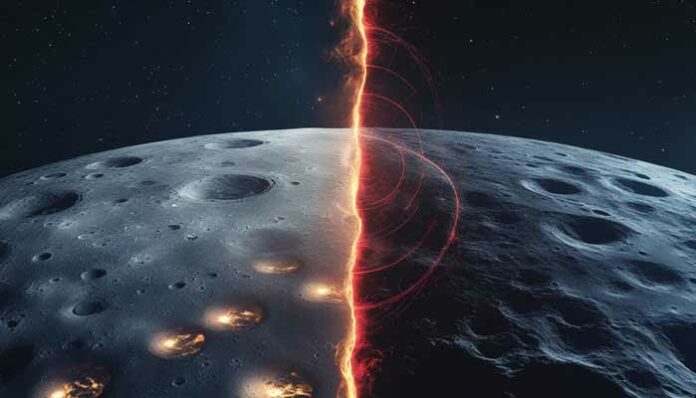Scientists have been puzzled for a long time about why the Moon’s two sides don’t look the same. Thanks to new information from two NASA robot spacecraft, we are now closer to understanding this mystery. Using information collected by two NASA robots, researchers have taken a close look at the Moon’s gravity.
Using information collected by two NASA robots, researchers have taken a close look at the Moon’s gravity. This study gives new clues about why the Moon’s front side, which faces Earth, and its far side, which faces away, are so unlike each other.
Scientists have learned more about the Moon’s gravity hidden makeup through NASA’s GRAIL mission. Their findings show that powerful volcanoes on the side facing Earth, active billions of years ago, created an uneven interior that influenced the Moon’s surface look.
For a long time, scientists have studied how the Moon moves around Earth. They now know that the side facing Earth stretches more during its orbit because of Earth’s gravity, a process called tidal deformation. This shows that the Moon’s interior, especially the mantle layer, is not the same on both sides. Moon’s gravity may also reflect the internal heat differences between the two sides.
How the Moon’s Heat and Ancient Lava Flows Created Its Surface
Ryan Park from NASA’s Jet Propulsion Lab explained in a recent study that the Moon’s gravity inside isn’t balanced. The part of the Moon facing Earth is warmer and more active deep down compared to the side we don’t see.
One side of the Moon, always facing Earth, is covered with vast, smooth plains made from lava that cooled ages ago. In contrast, the far side is rugged and filled with hills and mountains, lacking wide flat areas.
Keep Reading: The Moon is Beautiful Isnt It? Exploring the Enchantment of Our Celestial Companion
Understanding why the Moon’s two sides are so different has been a challenge for scientists. Some believe that long ago, intense volcanic activity on the side facing Earth caused heat-producing elements to build up beneath the surface. This recent study provides the clearest evidence yet to back up this explanation.
The Moon’s Core: Warm and Uneven Beneath the Surface
Experts believe that the area beneath the Moon’s side facing Earth is much warmer, by about 180 to 360 degrees Fahrenheit (100 to 200 degrees Celsius), than the opposite side. This extra heat might come from the breakdown of radioactive materials like thorium and titanium in that region.
According to Park, the Moon’s gravity near side and far side vary a lot. You can see this in their surface shapes, how thick their outer layers are, and the amount of elements inside that create heat.
The Moon measures about 2,160 miles (3,475 kilometers) wide, making it just over a quarter the size of Earth. Beneath its surface lies a thick layer called the mantle, which stretches from around 22 to 870 miles (35 to 1,400 kilometers) deep. This mantle forms most of the Moon’s weight and size. It mostly contains minerals like olivine and pyroxene, which also exist inside Earth.
Alex Berne, a scientist at Caltech and part of the study team, explained that the inside of the Moon isn’t even, and this matches what we see on its surface. For instance, the amount of old volcanic rock called mare basalts is different on the side facing Earth compared to the far side. This suggests that the forces that caused volcanoes billions of years ago might still be happening now. Berne also works at NASA’s Jet Propulsion Lab, where he helps design instruments to measure gravity on missions far out in space.
To better understand the Moon, scientists carefully examined information collected over several years by two spacecraft called Ebb and Flow. These probes orbited the Moon from December 2011 until December 2012, sending back valuable data for study.
Park explained, This is the best and most detailed picture we have of how gravity works on the Moon.
The new gravity map of the Moon is a big step forward. It helps build systems for positioning, navigation, and timekeeping, tools needed for future lunar missions. These systems will help spacecraft and astronauts move and work on the Moon more safely and accurately. The map also shows how gravity changes across the surface. This deeper understanding will support better timing and location systems. It will play a key role in future Moon exploration.
Researchers explained that gravity data from the Moon’s inner layers has opened up new possibilities. They believe this method could also help explore other places in our solar system. Scientists are especially interested in moons like Enceladus around Saturn and Ganymede around Jupiter. These moons might hold clues about life beyond Earth. Scientists could use the same technique to find out what lies beneath their surfaces.
These recent discoveries bring us closer to solving the Moon’s mysteries. The Moon, Earth’s steady partner in space, keeps revealing more about its nature and history. Each new finding helps us better understand this timeless celestial neighbor.
Earth’s closest neighbor plays a key role in keeping our planet’s rotation stable and creating ocean tides,” Park explained. “Human and robotic missions have taught us a lot about the Moon’s surface and inner layers. But many mysteries about its deep past still remain. As our nearest celestial companion, the Moon remains an important focus for science.

